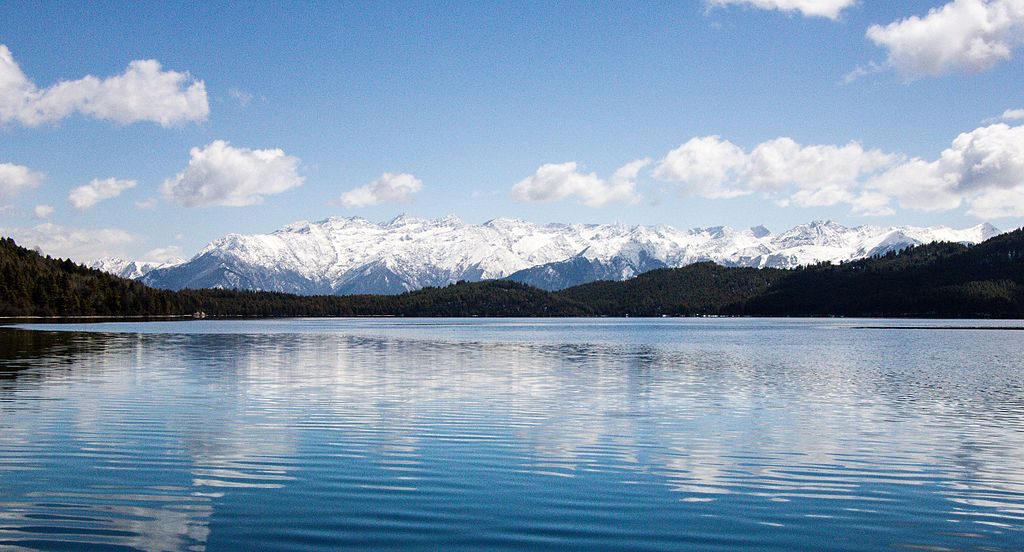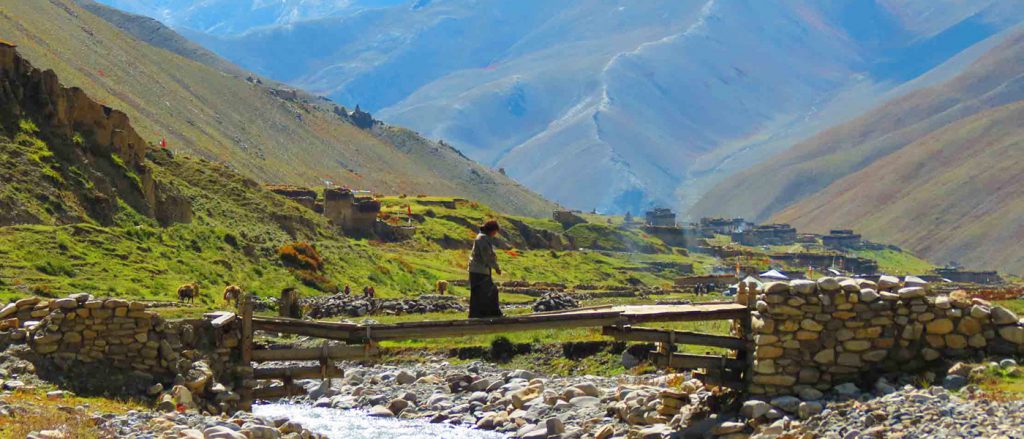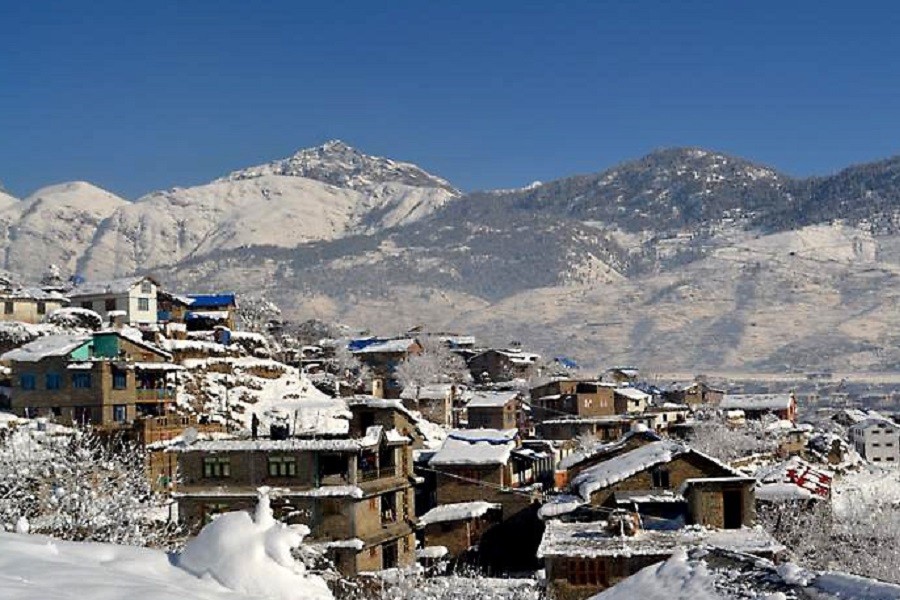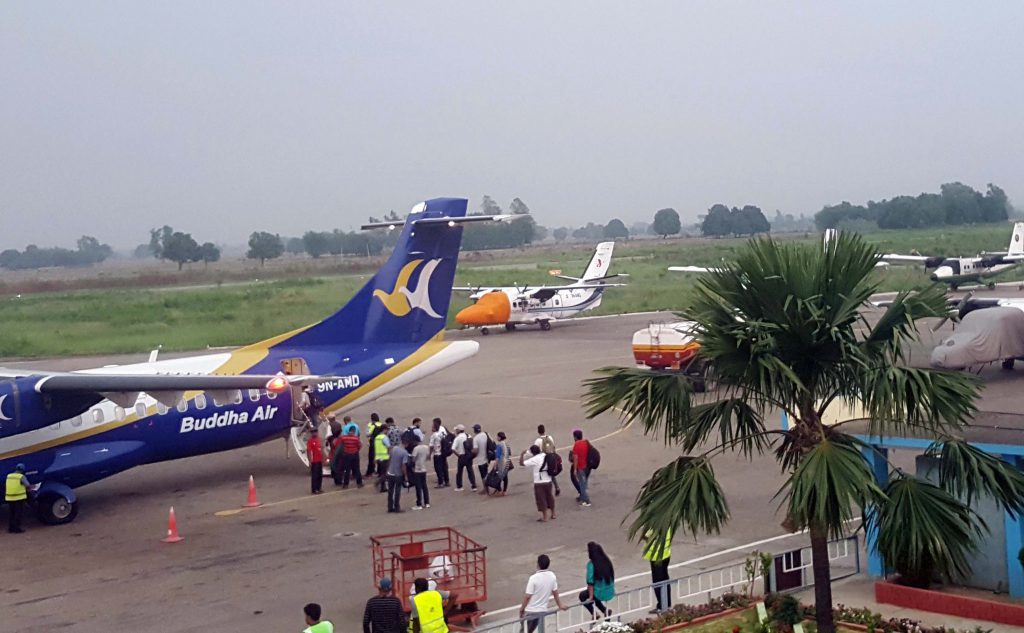Looking for something different away from the crowds; some real stillness in your life amongst pristine beauty at its best.
Well, why not a journey to secluded Rara Lake at 2,990 m. Rara is situated in the far northwestern part of Nepal, it is the smallest national park in the country, while the Lake is Nepal’s biggest and also its deepest. The hills surrounding Rara are spectacular, pine coniferous vegetation with more than 500 different kinds of flowers recorded to date in the immediate area. The rich vegetation of the park supports a diverse range of wildlife including the endangered red panda, musk deer, Himalayan black bear, leopard, jackal, Himalayan tahr. During winter the park supports many bird varieties: coots, great-crested grebe, black-necked grebe, red crested pochard, mallard, common teal, merganser, and gulls. Migrant waterfowl and other migratory birds can also be seen during certain seasons.
Our journey begins with a flight to Nepalgunj with a connecting flight to Jumla. From Rara Lake our trail is easy and we walk on a relatively straight path until Gamgadhi which is the headquarters of the remote Mugu District of Nepal. From Gamgadhi, we need to descend on a steep trail to Pina Village where we spend the night. From Jumla Rara is a 2-3 days trek away. Before moving on we visit Jumla where apple orchards are spread out over the hills to stock up for the days to come. The trek leads through the remote countryside as we make our way toward the Tibetan border. If you like peace, a journey to the beautiful Rara Lake and beyond is probably one of the most fascinating and rewarding times possible to have in Nepal. Totally undisturbed, come back refreshed.
- Secluded and as yet of yet an unspoiled remote region
- Nature at its best
- Pristine Rara Lake
- Outstanding landscapes and mountain views during the trek.
- Explore remote isolated villages
- Visit UNESCO world cultural heritage sites of the Kathmandu Valley.
One of our team will receive you at Tribhuvan International Airport for the transfer to your hotel. After time to settle you will be introduced to your tour guide for a tour briefing.The rest of the day is free to explore this bustling city.
After breakfast, we begin our sightseeing tour visiting UNESCO World Heritage Sites within Kathmandu. Kathmandu Durbar Square showcases Nepalese art and architecture at its best. The architecture is typical of the Malla dynasty who ruled over Nepal from the 12th to the 18th century. Swayambhunath Temple is popular among foreigners as the Monkey Temple owing to the large monkey population residing in the area. Pashupatinath Temple is situated on the banks of the Bagmati River and is one of the principal temples of Lord Shiva. The Bauddhanath Stupa is one of the largest stupas in South Asia which is built on the ancient trade route to Tibet.
After our short excursion in Kathmandu, we take an hour-long flight from Kathmandu to Nepalgunj, located in Western Nepal. Nepalgunj, a town near the Nepal-India border, is also the gateway to Simikot, Humla. The town itself is an interesting Terai town that showcases the diverse culture of Nepal. In Nepalgunj, we visit the local market, mini-zoo and nearby villages. Overnight in Nepalgunj.
We leave the Terai plains of Nepalgunj today and fly to the hilly landscape of Jumla, one of the least accessible districts in Nepal. Situated in the foothills of the Sisne Himalya, Jumla is also the gateway for trekkers who want to explore the remote Karnali region of Nepal. Overnight in Jumla.
Today we begin our trek. We leave Jumla and ascend to Chere Chaur along the Jugad Khola. On the way, we pass Khalanga Bazzar, a small market place for the nearby villages. We also pass a couple of villages and a temple before reaching our destination. Overnight in Chere Chaur.
From Chere Chaur we take the western trail and ascend slowly until the Jaljala pass (3580m). We cross the pass and continue trekking on a relatively straight trail until reaching Jaljala Chaur. From here we ascend on a steep trail and enter the Rara Lake Circuit before reaching Chalachaur. Overnight in Chalachaur.
It is an uphill climb to Sinja Valley. On the way we pass through several villages and walk along the Jaljala Khola (stream). Sinja Valley holds an important place in the history of Nepal. The valley houses the ancient capital city of the Khasa Kingdom that ruled this area from the 12th to the 14th century. Palaces, temples, and the ancient remains of a settlement were uncovered during excavations spearheaded by the Department of Archaeology at Cambridge University. Overnight in Sinja Valley.
We leave Sinja on an uphill trail alongside Hima River. From the village we climb on a steep trail for a while followed by a relatively easy trail until Laha Village. From Laha, it is a steep climb up until Ghorosingha alongside Ghatte khola (stream). Overnight in Ghorosingha.
We begin our steep ascent after breakfast. Our trail is alongside Chuchhemara Danda from where we get to admire the Himalayan panorama, the vast and tranquil Rara Lake, and the lush vegetation of the Rara National Park. On the way to Rara Lake, we pass through Khatyar Khola Camp and a few villages including Murma. From Murma, the ascent gets a little easier. We continue walking towards Chapri village which houses the Rara National Park Head Quarter. Overnight at Rara Lake.
Rara Lake is the largest freshwater lake in Nepal. After breakfast we investigate the azure waters of the massive lake also referred to as Mahendra Taal (Lake) after late king Mahendra. While boating we get to admire the picturesque setting of the lake and discover quite a few varieties of fish. Chuchemara Peak lies on the southern side of the Rara Lake whereas Ruma Kand and Malika Kand peaks frame its northern area. Overnight at Rara Lake.
From Rara Lake our trail is easy and we walk on a relatively straight path until Gamgadhi which is the headquarters of the remote Mugu District of Nepal. From Gamgadhi, we descend on a steep trail to Pina Village where we spend the night.
From Pina we descend and cross the Ghurchi Lagna pass at 3480 m. We continue our descent and pass through a few villages before reaching Bumra. The Bumra village is also known as Nauri Ghat.
We cross two suspension bridges above Hima River and walk downhill. After walking for a few hours, we get to a hot spring where we can ease our aching body with a dip. Not long after the hot spring, we cross Danphe Lagna pass at 3691 m. After reaching Cherechaur, we follow the same trail we took couple of days back and reach Jumla. Overnight in Jumla.
We take the earliest flight available to Nepalgunj from Jumla. After reaching Nepalgunj, we fly yet again to Kathmandu, the capital city of Nepal. After reaching Kathmandu, we freshen up and take a rest. In the evening there will be a farewell dinner hosted by Himalayan Glacier to celebrate the successful completion of the Rara Lake trek. Overnight in Kathmandu.
Himalaya Heart reserves this day as contingency or free day in case of flight delay and cancellation in Jumla, which can occur sometimes due bad and unfavorable weather conditions beyond our control.
If all goes well we can us this spare day for an optional tour of places of interest around old heritage sites of Kathmandu-Patan or Bhaktapur or leave free for individual activities and shopping.
Time to move on, we hope you have enjoyed your time with us and would like to meet you again at some future stage.One of our team will assist with your transfer to the airport for your onward destination.
Cost Included
- Pick up from Airport and Transfer to the hotel by private car.
- Four night’s 3* Hotel in Kathmandu with breakfast.
- All necessary paper work.
- Domestic airfare as per the itinerary.
- Lunch, Dinner & breakfast during trek.
- Accommodation in lodges/tea houses during the trek.
- ‘Trekkers’ Information Management System (TIMS) Permit.
- An experienced, Licensed Guide and trek team.
- Arrangement for Travel rescue.
- Medical supplies (first aid kit will be available).
- All government taxes.
- Last Night farewell dinner at an authentic Nepalese restaurant with a cultural performance.
Cost Not Included
- Nepal Visa fee you may obtain easily in Kathmandu airport.
- International airfare to and from Kathmandu.
- All meals other than breakfast in Kathmandu
- Travel and rescue insurance.(you must have emergency evacuation cover)
- Personal expenses (phone calls, laundry, bar bills, battery recharge, extra porters, bottle or boiled water, shower
- Tips for staff (expected but not mandatory)
Pristine Undiscovered Rara Lake Trek FAQ
You can buy virtually everything you need for trekking from down jackets to water bottles in Kathmandu. There is a variety of branded stores as well as a large selection of copied products mainly in Thamel that are of fairly good quality. It’s still worth bringing your own gear if it doesn’t take up too much weight, especially your own trekking boots to avoid any potential issues when purchasing new shoes..
You should bring trekking boots that are comfortable and broken in. There can be some snow at higher altitudes especially when crossing high passes, so it’s good to be prepared for a variety of conditions. Your footwear should be strong and durable. It should have a chunky sole—preferably made of Vibram or another durable material—and should also protect your ankles..
Most days in the mountains involve 4-6 hours and longer of trekking. When you consider your day starts at 8 am and ends around 4-5 pm, it’s not too arduous as you’ll be taking a number of breaks and stopping for lunch along the way. The higher you get in elevation (especially in the Everest region), the shorter your trekking days will get to ensure we minimize the risk of altitude sickness
Tipping is not required but is expected, and really depends on how happy you were with the service. Guides (both for trekking and cultural tours), porters, and drivers are typically provided with a tip at the end of their service with you..
You only need to carry your day pack with daily essentials (sunblock, water, hat, light jacket, and camera) Our porters carry the bulk of your gear, such as extra clothing and overnight essentials.
All of our guides at Himalaya Heart speak English and have had many years of experience in guiding foreign travelers. It’s a requirement that they all are trained in first aid as well and we carry a first aid kit during the trek.
For group treks (treks that start on a specific date and are open for travelers to join), the group size can range from 2-10 people but typically ends up being around 4-6 people.
If you fall ill during your trek, the course of action depends on what’s wrong. If it’s altitude sickness, moving to lower altitudes and taking altitude medication will solve this in most cases; if it’s severe, our guide will arrange for an emergency evacuation by helicopter Himalayan Heart will cover the initial costs then claim from your insurer (be sure that emergency helicopter rescue is covered in your travel insurance it is an essential requirement before travelling with us). If you have stomach sickness or another type of food or water-related illness, our guide will have medication on-hand for most common illnesses.
When is the best time to visit Nepal?
The main seasons for trekking are the spring (Mar to May) and autumn (Sep to Nov) when you’ll have clear skies and superb mountain views. The winter (Dec to Feb) is also a great time to visit— these months offer a unique experience and fewer crowds but lower altitude treks are better at this time of year as its cold at night.
What is it like during the monsoon season?
(Jun to Aug), Most of Nepal experiences heavy rain for a few hours each day. It’s humid, wet, and the trails in the lower regions (Ghorepani, Ghandruk, Langtang, etc) can be quite muddy. If you don’t mind the rain you’ll have the trails to yourself, the skies often clear up in the morning, and certain treks offer stone-paved trails that drain the rain and make for easy trekking. Also, certain regions, like Mustang and the upper reaches of Everest, lie in the rainshadow of the Himalaya and receive little rain but views however are still likely to be restricted.
What is Altitude Sickness?
Many sites on Google speak about 2.500 meters as when problems may arise. In our experience this is misleading you may feel a slight headache but rarely anything more that a painkiller won’t relieve. If we are talking about the possibility of contracting a more severe form of altitude sickness it is likely to occur over 4.000 meters and once again rare and easily resolved by descending to a lower altitude. Altitude sickness describes several symptoms that happen to your body when you’re exposed to a higher elevation within a short period of time. When people are traveling or either climbing to a higher elevation quickly. The higher you climb, the lower the air pressure and oxygen levels get. Our bodies can handle the shift, but they need time to gradually adjust. Himalaya Heart carefully designs treks to minimise any risk.Having said that many people will experience the following to a lesser or higher degree this is not acute mountain sickness.
Lack of appetite, nausea
Fatigue or weakness
Dizziness or light-headedness
Insomnia
Needles and Pins Sensation
Shortness of breath
Money and payment in Nepal ?
Payment in hotels, trekking/travel agencies, and airlines are made in foreign exchange. Most of the International Cards including Visa Card, Master Card, JCB, Maestro, Americal Express etc. are widely accepted by hotels, restaurants and leading travel/trekking agents. The receipts may be needed to change left-over Nepalese Rupees into hard currency before leaving the country. However, only 10 percent of the total amount may be converted by the bank. ATM and Debit cards are widely in use in major cities of Kathmandu, Pokhara, Chitwan, Lumbini and others. Nepalese Rupees are found in denominations of 1000, 500, 100, 50, 20, 10, 5, 2 and 1. One rupee equals 100 paisa. The rate regularly fluctuates and is fixed and published by Nepal Rastra Bank every other day. There are also many Government liscensed money exchange shops in major tourist areas throughout Nepal where rates are generally good (around 2%) fixed by the Government.
What’s the difference between private and group tours?
Private tours are tailor-made itineraries built by us around your travel dates and personal interests, whereas group trips are pre-packaged and depart on specific dates. Group trips are also open for others to join, whereas private trips are just for you. You will find a list of fixed departure dates on our website.
How do I get my visa for Nepal?
For most nationalities visa can be obtained on arrival in Kathmandu. It takes around 45 minutes and is the most convenient way to get your visa you will need passport size photos.. You can also apply for a visa in advance from a local Nepali consulate in your country if you’d like to have everything arranged in advance. Cost15 Days – 25 USD / 30 Days – 40 USD / 90 Days – 100 USD
How much luggage can I take on domestic flights?
For mountain flights, you’re allowed 5 kg. carry-on to the plane and 10 kg. for checked-in luggage. For non-mountain sector flights, the check-in allowance increases to 20-25 kg.
Are hotels included in the tour price?
Himalaya Heart organises complete tours, meaning everything is taken care of from the moment you arrive in Nepal to the moment you leave, including all of your accommodation in a three star Hotel. If you require better accommodation please let us know and we can arrange this and adjust the tour cost accordingly. Each of our tour pages shows clearly what is and what is not included in the tour price.
Are there any extra expenses not included in my tour price?
Personal expenses (tips, soft drinks, bar bills, laundry, telephone calls, donations, and extra snacks, etc) are not included in your tour price. When checking a particular trek page on our website we have clearly stated what is and what is not included. If you’re going trekking, the only things you’ll need to pay for out of pocket are wifi and battery charging (when available), extra meals outside of what’s included, alcohol, and soft drinks and perhaps hot showers.

 +977 9851093973 (Thakur)
+977 9851093973 (Thakur)



